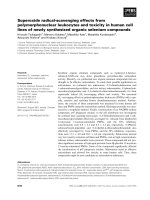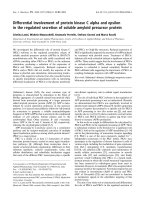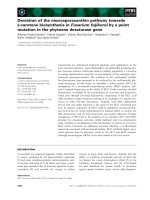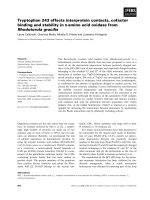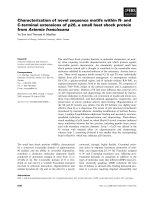Báo cáo khoa hoc:" Gliomatosis cerebri presenting as rapidly progressive dementia and parkinsonism in an elderly woman: a case report" ppt
Bạn đang xem bản rút gọn của tài liệu. Xem và tải ngay bản đầy đủ của tài liệu tại đây (358.59 KB, 4 trang )
BioMed Central
Page 1 of 4
(page number not for citation purposes)
Journal of Medical Case Reports
Open Access
Case report
Gliomatosis cerebri presenting as rapidly progressive dementia and
parkinsonism in an elderly woman: a case report
Emmanuelle Duron*, Anne Lazareth, Jean-Yves Gaubert, Carole Raso,
Olivier Hanon and Anne-Sophie Rigaud
Address: Department of Geriatrics, University René Descartes. Broca Hospital, AP-HP, France
Email: Emmanuelle Duron* - ; Anne Lazareth - ; Jean-Yves Gaubert - jean-
; Carole Raso - ; Olivier Hanon - ; Anne-Sophie Rigaud - anne-
* Corresponding author
Abstract
Introduction: Dementia is one of the most important neurological disorders in the elderly.
Dementia of tumoral origin is rare and parkinsonism of neoplastic origin is unusual. We herein
report a case of gliomatosis cerebri, a very rare brain tumor seldom affecting the elderly, which
presented as rapidly progressive dementia and parkinsonism.
Case presentation: An 82-year-old woman very rapidly developed progressive dementia and
akineto-rigid parkinsonism. Brain CT scan was normal. Cerebral magnetic resonance imaging (MRI)
with gadolinium injection highlighted a diffuse tumor-related infiltration involving both lobes, the
putamen, the pallidum, the substantia nigra, and the brainstem, corresponding to the specific
description and definition of gliomatosis cerebri.
Conclusion: This atypical presentation of a gliomatosis cerebri, and the infiltration of the
substantia nigra by the tumor, merits attention.
Introduction
Dementia is one of the most important neurological dis-
orders in the elderly.
In occidental countries, the most common forms of
dementia are Alzheimer's disease and vascular dementia,
with frequencies of 70 and 15%, respectively. Dementia of
tumoral origin is rare. It may be related either to the
tumour itself, especially primary central nervous system
lymphoma or low grade glioma, or to the tumour's treat-
ment (radiation-induced encephalopathy). Secondary
parkinsonism is frequent among elderly people. It
includes drug-induced parkinsonism (due to Dopamine
Receptor Blockers) and vascular parkinsonism. Neverthe-
less, parkinsonism of neoplastic origin is unusual. We
herein report a case of probable gliomatosis cerebri, a very
rare brain tumor seldom affecting the elderly, which pre-
sented as rapidly progressive dementia and parkinsonism.
Case presentation
Following a fall, an 82-year-old woman was admitted to
the Broca University Hospital. According to her family,
she had exhibited cognitive impairment for several
months. The patient was undergoing treatment for hyper-
tension with Candesartan (Angiotensin Receptor Block-
ers) and her type 2 diabetes was satisfactorily controlled
Published: 20 February 2008
Journal of Medical Case Reports 2008, 2:53 doi:10.1186/1752-1947-2-53
Received: 31 August 2007
Accepted: 20 February 2008
This article is available from: />© 2008 Duron et al; licensee BioMed Central Ltd.
This is an Open Access article distributed under the terms of the Creative Commons Attribution License ( />),
which permits unrestricted use, distribution, and reproduction in any medium, provided the original work is properly cited.
Journal of Medical Case Reports 2008, 2:53 />Page 2 of 4
(page number not for citation purposes)
by diet. The physical examination at the time of admis-
sion revealed an akineto-rigid bilateral, symmetrical par-
kinsonism. Her gait demonstrated marked reduction in
arm swing. She displayed bilateral bradykinesia, limb
rigidity and hypomimia. Her voice was monotonous and
hypophonic. There was neither tremor nor orthostatic
hypotension. She scored 18/30 on the Mini-Mental Status
Examination (MMSE) [1] and scored very low on the Cog-
nitive Efficiency Profile [2], a complete validated compre-
hensive cognitive battery assessment, indicating a major
dysexecutive syndrome (perseveration, judgment trouble,
confabulation, anosognosia and apathy) and memory
impairment (short and medium recall). There were also
deficits on tests of visuospatial ability. Conversely, nam-
ing was preserved. Basic biological screening tests (i.e.
blood cell count, blood chemistry, C-reactive protein, thy-
roid stimulating hormone, vitamin B12 and folic acid)
were normal, as well as a non-injected computed tomog-
raphy brain scan (Figure 1). An electro-encephalogram
demonstrated slow waves, especially at the level of the left
temporal lobe. Allowing for this dementia with parkin-
sonism, the first diagnostic hypothesis was dementia with
Lewy bodies.
Shortly following her evaluation, the akinesia and rigidity
worsened, and a frontal syndrome developed. An L-dopa
treatment was introduced as well as an anticholinesterase
treatment (Galantamine) without any improvement
noted.
Two months after the hospital admission, the MMSE score
was 5/30. Cerebral magnetic resonance imaging (MRI)
with gadolinium injection highlighted a diffuse tumor-
related infiltration involving both lobes, the putamen, the
pallidum, the substantia nigra and the brainstem, corre-
sponding to the specific description and definition of gli-
omatosis cerebri [3] (Figures 2 and 3).
Fifteen days later, the patient died of urinary sepsis just
before the initiation of chemotherapy.
Discussion
The association of parkinsonism, falls and dementia is
suggestive of a dementia with Lewy bodies [4]. Indeed,
very rapidly progressing dementias with Lewy bodies have
been described [5,6]. However, the lack of recurrent hallu-
cinations, delusions and fluctuating cognition and the
Axial fluid-attenuated inversion recovery MRI image demon-strating tumor-related infiltration involving both temporal lobes (Short arrow), and the substantia nigra (Long arrow)Figure 2
Axial fluid-attenuated inversion recovery MRI image
demonstrating tumor-related infiltration involving
both temporal lobes (Short arrow), and the substan-
tia nigra (Long arrow).
Normal non-injected computed tomography brain scanFigure 1
Normal non-injected computed tomography brain
scan.
Journal of Medical Case Reports 2008, 2:53 />Page 3 of 4
(page number not for citation purposes)
absence of treatment response to treatment did not favour
this diagnosis in our patient [4]. Furthermore, a diagnosis
of multiple system atrophy was also considered, but
rejected because of the very rapid course of the disease [7].
The MRI with gadolinium injection highlighted typical
images of gliomatosis cerebri (i.e., diffusely infiltrative gli-
omas, without an obvious tumor mass, involving more
than two lobes and extending to an infratentorial struc-
ture [3]), whose topography was consistent with this
patient's symptoms.
Cognitive disorders are rarely caused by brain tumours
but they have been reported as relatively common symp-
toms of primary brain lymphomas, low grade gliomas, or
gliomatosis cerebri [8].
Parkinsonism of neoplastic origin is also rare. Usually this
is due to tumors not involving the basal ganglia, such as
astocytomas, meningiomas, craniopharyngiomas, colloid
cysts, and less frequently, metastases [9].
On the other hand, tumours of the basal ganglia are rarely
accompanied by parkinsonism [9], which is why brain
lymphomas are frequently seen to involve basal ganglia,
but without symptoms of parkinsonism [10].
Moreover, in our patient, the MRI with gadolinium injec-
tion highlighted lesions of gliomatosis cerebri with the
rarely observed involvement of the substantia nigra (Fig-
ure 2). This topography explained the symptoms of, par-
kinsonism at least in part since the pallidum was also
involved (Figure 3), with presynaptic dysfunction of the
nigro-striatal pathway. Moreover, lesions of the connect-
ing fibers in the white matter, implicated in frontal-sub-
cortical circuits, must have contributed to the
development of parkinsonism and dementia in this
patient. Some small nodes were enhanced with gadolin-
ium injection.
Gliomatosis cerebri is a rare tumor. An extensive review
encompassed 22 cases with a mean occurrence age of 49
years [3]. The main symptoms are dementia, seizures, and
hemiparesis. To our knowledge, the symptoms affecting
our patient have been reported only in three other cases
[11-13], but this case is noteworthy in having an atypical
symptomatology and also the first reported lesion in the
substantia nigra, as shown by MRI. Nevertheless, although
the MRI images are typical of gliomatosis cerebri, a limita-
tion of this case report is the lack of pathological confir-
mation of the diagnosis.
Conclusion
This atypical presentation of a gliomatosis cerebri, and the
infiltration of the substantia nigra by the tumor, merits
attention.
Competing interests
The author(s) declare that they have no competing inter-
ests.
Authors' contributions
All authors participated in the care of the patient
described. ED wrote the manuscript. AL, JYG, CR collected
data and helped to draft the manuscript. OH and ASR crit-
ically revised the content of the manuscript. All authors
have read and approved the final version of the manu-
script.
Consent
Written informed consent was obtained from the next of
kin of the patient described in this case report for publica-
tion of this case report and the accompanying images. A
copy of the written consent is available for review by the
Editor-in Chief of this journal.
Axial fluid-attenuated inversion recovery MRI image demon-strating tumor-related infiltration involving lenticular nuclei (Arrow)Figure 3
Axial fluid-attenuated inversion recovery MRI image
demonstrating tumor-related infiltration involving
lenticular nuclei (Arrow).
Publish with BioMed Central and every
scientist can read your work free of charge
"BioMed Central will be the most significant development for
disseminating the results of biomedical research in our lifetime."
Sir Paul Nurse, Cancer Research UK
Your research papers will be:
available free of charge to the entire biomedical community
peer reviewed and published immediately upon acceptance
cited in PubMed and archived on PubMed Central
yours — you keep the copyright
Submit your manuscript here:
/>BioMedcentral
Journal of Medical Case Reports 2008, 2:53 />Page 4 of 4
(page number not for citation purposes)
References
1. Folstein MF, Folstein SE, McHugh PR: "Mini-mental state". A
practical method for grading the cognitive state of patients
for the clinician. J Psychiatr Res 1975, 12:189-98.
2. De Rotrou J, Forette F, Tortrat D, Fermanian J, Hervy MP, Boudou
MR: The Cognitive Efficiency Profile: description and valida-
tion in patients with Alzheimer's disease. Int J Geriatr Psychiatry
1991, 6:501-9.
3. Vates GE, Chang S, Lamborn KR, Prados M, Berger MS: Gliomatosis
cerebri: a review of 22 cases. Neurosurgery 2003, 53:261-71.
4. McKeith IG, Dickson DW, Lowe J, Emre M, O'Brien JT, Feldman H,
Cummings J, Duda JE, Lippa C, Perry EK, Aarsland D, Arai H, Ballard
CG, Boeve B, Burn DJ, Costa D, Del Ser T, Dubois B, Galasko D,
Gauthier S, Goetz CG, Gomez-Tortosa E, Halliday G, Hansen LA,
Hardy J, Iwatsubo T, Kalaria RN, Kaufer D, Kenny RA, Korczyn A, et
al.: Consortium on DLB. Diagnosis and management of
dementia with Lewy bodies: third report of the DLB Consor-
tium. Neurology 2005, 65:1863-72.
5. Miamian-Mayor I, Pizzolato GP, Burkhardt K, Landis T, Coeytaux A,
Burkhard PR: Fulminant Lewy body disease. Mov Disord 2006,
21:1748-51.
6. Armstrong TP, Hansen LA, Salmon DP, Masliah E, Pay M, Kunin JM,
Katzman R: Rapidly progressive dementia in a patient with the
Lewy body variant of Alzheimer's disease. Neurology 1991,
41:1178-80.
7. Gilman S, Low PA, Quinn N, Albanese A, Ben-Shlomo Y, Fowler CJ,
Kaufmann H, Klockgether T, Lang AE, Lantos PL, Litvan I, Mathias CJ,
Oliver E, Robertson D, Schatz I, Wenning GK: Consensus state-
ment on the diagnosis of multiple system atrophy. J Neurol Sci
1999, 163:94-8.
8. Taphoorn MJ, Klein M: Cognitive deficits in adult patients with
brain tumours. Lancet Neurol 2004, 3:159-68.
9. Bhatoe HS: Movement disorders caused by brain tumours.
Neurol India 1999, 47:40-2.
10. Sanchez-Guerra M, Cerezal L, Leno C, Diez C, Figols J, Berciano J:
Primary brain lymphoma presenting as Parkinson's disease.
Neuroradiology 2001, 43:36-40.
11. Molho ES:
Gliomatosis cerebri may present as an atypical par-
kinsonian syndrome. Mov Disord 2004, 19:341-4.
12. Asada T, Takayama Y, Tokuriki y, Fukuyama H: Gliomatosis cere-
bri presenting as a parkinsonian syndrome. J Neuroimaging
2007, 17:269-71.
13. Slee M, Pretorius P, Ansorge O, Stacey R, Butterworth R: Parkin-
sonism and dementia due to gliomatosis cerebri mimicking
sporadic Creutzfeldt-Jakob disease (CJD). J Neurol Neurosurg
Psychiatry 2006, 77:283-4.



